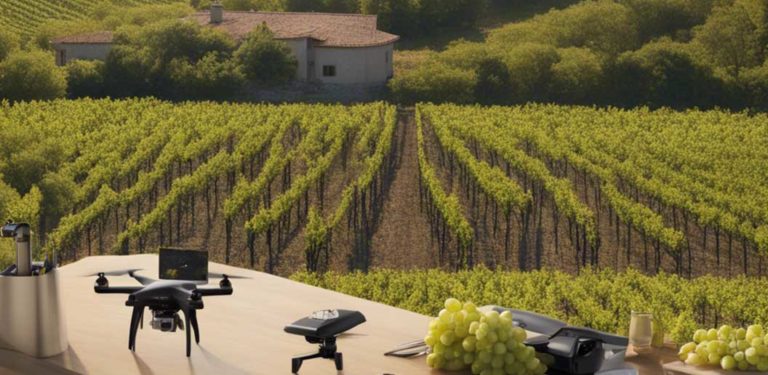In the realm of winemaking, tradition has long been the guiding force, with age-old methods passed down through generations. However, just like the rest of the world, the world of wine is undergoing a transformative journey, challenging preconceived notions and embracing modern techniques. The evolution of winemaking goes beyond the traditions, as winemakers around the globe explore innovative approaches that enhance quality, sustainability, and the overall winemaking experience.
Embracing Technology in the Vineyard
Modern winemaking begins in the vineyard, where technology plays a crucial role in optimizing grape cultivation. Drones equipped with advanced sensors monitor vine health, enabling winemakers to assess the precise needs of each grapevine or the ideal harvest time. This data-driven approach allows for targeted interventions, minimizing the use of pesticides and fertilizers while maximizing grape quality.
Additionally, the use of GPS technology aids in precision viticulture, mapping variations in soil composition and microclimates. By understanding these nuances, winemakers can tailor their practices to specific vineyard sections, ensuring optimal grape development and ripening. This level of precision was unthinkable in traditional winemaking, highlighting the positive impact technology can have on grape cultivation.
Innovative Fermentation Techniques
Fermentation, a pivotal stage in winemaking, has witnessed significant innovation. While traditional methods, such as oak barrel fermentation, persist, winemakers are experimenting with alternatives. Stainless steel tanks and concrete eggs are gaining popularity, offering greater control over temperature and fermentation kinetics. These vessels provide a neutral environment, allowing the pure expression of grape characteristics without the influence of external flavors.
Moreover, the use of indigenous yeasts is making a comeback. Unlike commercial yeasts, which are often employed in traditional winemaking, indigenous yeasts are naturally present in the vineyard and winery environment. Harnessing these native microorganisms contributes to the uniqueness of the wine, reflecting the terroir and biodiversity of the region. What makes this resurgence even more significant is the modern techniques that make it easier for winemakers to safely cultivate indigenous yeast. Advanced microbial analysis and fermentation management tools allow winemakers to identify and monitor indigenous yeast strains with precision, ensuring a controlled and reliable fermentation process. This technological facilitation not only preserves the spontaneity and authenticity associated with indigenous yeasts but also provides winemakers with the necessary tools to navigate the process safely, resulting in wines that are not only distinctive but also consistently of high quality. As the marriage of tradition and technology continues to evolve, the reintegration of indigenous yeasts into winemaking stands as a testament to the industry’s commitment to preserving the natural character of grapes while embracing the benefits of modern advancements. For a good example of wine made from indigenous yeast pay a visit to the newly opened Hua Hin restaurant Gregal and try the wines of Alois Lageder.
Precision Winemaking using AI
AI, the cutting-edge technology of our era, has found a surprising application in the ancient art of winemaking. By harnessing the power of artificial intelligence, winemakers can delve even deeper into the nuances of grape cultivation and winemaking processes. AI algorithms analyze vast datasets, including weather patterns, soil compositions, and historical winemaking practices, to provide actionable insights. This data-driven approach enhances decision-making at every stage, from predicting optimal harvest times to recommending fermentation strategies.
Additionally, AI-powered sensory analysis tools can assess the nuances in taste and aroma, aiding winemakers in crafting wines that resonate with the evolving preferences of modern consumers. The marriage of AI and winemaking exemplifies how technology is not just transforming industries but also enhancing the craft of turning grapes into exceptional wines.
Sustainable Practices and Minimal Intervention
Modern winemaking emphasizes sustainability, with winemakers adopting eco-friendly practices to minimize the environmental impact. Organic and biodynamic farming techniques, once considered unconventional, are gaining widespread acceptance. These methods prioritize soil health, biodiversity, and natural resource conservation, resulting in wines that are not only environmentally friendly but also authentic representations of their terroir.
The trend towards minimal intervention winemaking is another testament to the evolving landscape. By allowing the grapes to express themselves without excessive manipulation, winemakers showcase the inherent beauty of the fruit. This approach requires a delicate balance, as winemakers tread lightly to capture the essence of the vineyard while maintaining quality and consistency.
As the industry continues to evolve, winemakers are not discarding tradition but rather building upon it, ensuring that each bottle tells a story of the past, present, and the future of winemaking. In this ever-changing landscape, one thing is certain: the world of wine is far from static, and its continual evolution is what keeps it a vibrant and captivating pursuit for both winemakers and enthusiasts alike.


